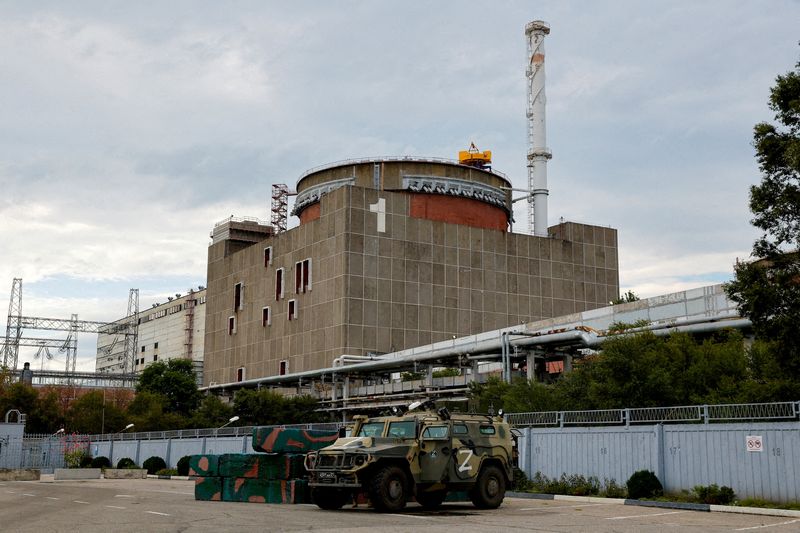Explainer-What are the risks to Ukraine’s nuclear reactors in war
2022.10.11 11:33
[ad_1]
2/2

© Reuters. FILE PHOTO: A Russian all-terrain armoured vehicle is parked outside the Zaporizhzhia Nuclear Power Plant during the visit of the International Atomic Energy Agency (IAEA) expert mission in the course of Ukraine-Russia conflict outside Enerhodar in the Za
2/2
By Guy Faulconbridge
LONDON (Reuters) – Repeated shelling of the Zaporizhzhia nuclear power plant in southern Ukraine has raised the possibility of a grave accident just 500 km (300 miles) from the site of the world’s worst nuclear accident, the 1986 Chernobyl disaster.
The International Atomic Energy Agency (IAEA), which has repeatedly expressed concerns over the shelling of the plant, has proposed the establishment of a nuclear safety and security protection zone around the plant.
What nuclear material is at Europe’s largest nuclear power plant, what are the risks and why are Russia and Ukraine fighting over it?
WHAT IS IT?
The Zaporizhzhia nuclear power plant has six Soviet-designed VVER-1000 V-320 water-cooled and water-moderated reactors containing 235, which has a half-life of more than 700 million years.
Construction began in 1980 and its sixth reactor was connected to the grid in 1995. All six reactors are now in cold shutdown after reactor No. 6 was shut down on Sept. 12.
A cold shutdown means the reactor’s temperature is below boiling point but electrical pumps moving water through the reactor core must still keep working to cool the fuel.
The plant is no longer producing electricity.
WHAT ARE THE RISKS?
The biggest risk is from overheating nuclear fuel, which could happen if the power that drives the cooling systems was cut. Shelling has repeatedly cut power lines.
The plant lost its last remaining external power on Oct. 8, leaving it reliant on diesel generators for more than a day, the International Atomic Energy Agency said. The power line was restored on Oct. 9.
Before the war, the plant had four high-voltage power lines giving it access to the grid as well as several backup lines.
COULD THE REACTOR MELT DOWN?
Pressurised water is used to transfer heat away from the reactors even when they are shutdown, and pumped water is also used to cool down removed spent nuclear fuel from the reactors.
If the power was cut and auxiliary systems such as 20 diesel generators (which have enough diesel for 10 days) failed to keep the reactors cool, then the fuel could meltdown and the zirconium cladding could release hydrogen.
A meltdown of the fuel, which remains extremely hot for some time even after the reactor shutdown, could begin a fire or explosion that could release a plume of radionuclides into the air where they could be spread over a large area.
The Chernobyl accident spread Iodine-131, Caesium-134 and Caesium-137 across parts of northern Ukraine, Belarus, Russia, northern and central Europe.
WHAT ABOUT THE SPENT FUEL?
Besides the reactors, there is also a dry spent fuel storage facility at the site for used nuclear fuel assemblies, and spent fuel pools at each reactor site that are used to cool down the used nuclear fuel.
“The basins of spent fuel are just big pools with uranium fuel rods in them – they are really hot depending on how long they have been there,” Kate Brown, an environmental historian at the Massachusetts Institute of Technology whose book “Manual for Survival” documents the full scale of the Chernobyl disaster, said in August.
“If fresh water is not put in, then the water will evaporate. Once the water evaporates, then the zirconium cladding will heat up and it can catch fire and then we have a bad situation – a fire of irradiated uranium which is very like the Chernobyl situation releasing a whole complex of radioactive isotopes.”
An emission of hydrogen from a spent fuel pool caused an explosion at reactor 4 in Japan’s Fukushima nuclear disaster in 2011.
According to a 2017 Ukrainian submission to the IAEA, there is a total of more than 2,200 tonnes of nuclear material excluding the reactors, according to the document.
WHO CONTROLS IT?
After invading Ukraine on Feb. 24, Russian forces took control of the plant in early March.
Special Russian military units guard the facility and Russian nuclear specialists are on site. Ukrainian staff continue to help operate the plant.
After Russian President Vladimir Putin annexed up to 18% of Ukraine, including the area where the nuclear plant is located, he signed a decree on Oct. 5 to formalise Russian control over the plant.
Ukraine’s state nuclear company Energoatom says Russian forces have increased their presence at the plant and has called on Ukrainian staff not to agree to sign new contracts.
IAEA Director General Rafael Grossi has proposed the establishment of a nuclear safety and security protection zone around the plant.
[ad_2]
Source link








